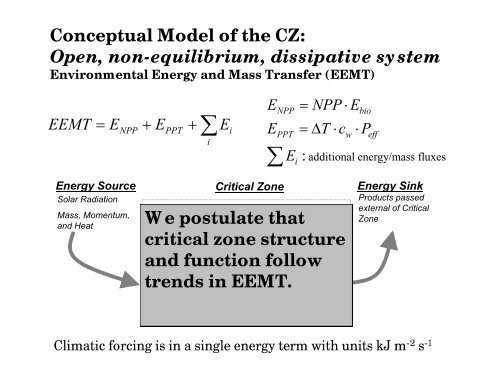Critical Zone Observatory - University of Arizona
Critical Zone Observatory - University of Arizona
Critical Zone Observatory - University of Arizona
Create successful ePaper yourself
Turn your PDF publications into a flip-book with our unique Google optimized e-Paper software.
Conceptual Model <strong>of</strong> the CZ:<br />
Open, non-equilibrium, dissipative system<br />
EEnvironmental i t l E Energy and d Mass M TTransfer f (EEMT)<br />
EEMT<br />
=<br />
E<br />
NPP<br />
Energy Source<br />
Solar Radiation<br />
Mass Mass, Momentum<br />
Momentum,<br />
and Heat<br />
+ E<br />
PPT<br />
+<br />
∑ E<br />
i<br />
i<br />
ENPP = NPP⋅Ebio E =ΔT⋅c ⋅P<br />
∑<br />
<strong>Critical</strong> <strong>Zone</strong><br />
PPT w eff<br />
E<br />
EEMT<br />
We postulate that<br />
critical zone structure<br />
EEM<br />
Catchment<br />
and Chemical C e ca function Energy e gy follow<br />
Structural organization<br />
(e.g., carbon and water)<br />
• Vegetation structure<br />
trends in EEMT. • Soil catena<br />
Gravitational Energy<br />
• Drainage networks<br />
(e.g., sediment and water)<br />
• Topography<br />
i<br />
:<br />
additional energy/mass fluxes<br />
Energy Sink<br />
Products passed<br />
external <strong>of</strong> <strong>Critical</strong><br />
<strong>Zone</strong><br />
Climatic forcing is in a single energy term with units kJ m -2 s -1


